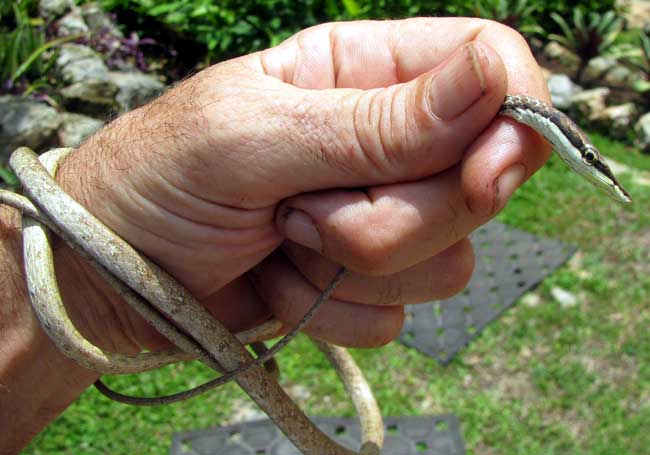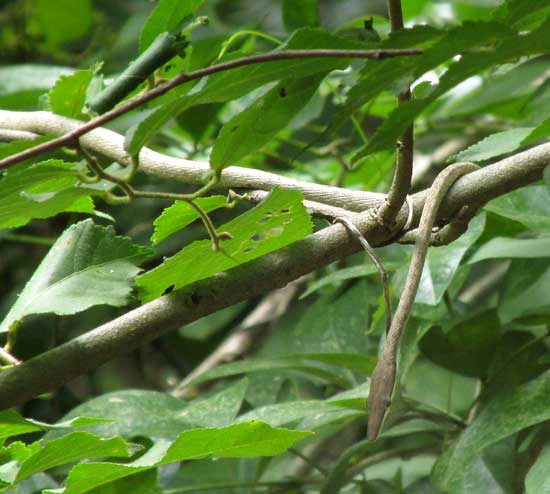Excerpts from Jim Conrad's
Naturalist Newsletter

from the June 6, 2010 Newsletter issued from Hacienda Chichen Resort beside Chichén Itzá Ruins, central Yucatán, MÉXICO; limestone bedrock, elevation ~39m (~128ft), ~N20.676°, ~W88.569°
GULF COAST VINE SNAKE
This time the critter was cornered on the grass outside the kitchen. That's him above. A close-up of the very long, slenderly pointed head is shown below:

That's a Brown Vine Snake, OXYBELIS AENEUS*, famous for it incredible slenderness. The one in my hand is about is about three feet long (1 m) and when it's stretched out it's hard to believe that such a thin body would have enough muscles for it to move about.
He did have enough musculature, though, to offer some quick strikes at my hand, which made a great show but never made contact. Once he was caught he became very tame, not squirming at all.
GULF COAST VINE Snakes specialize in moving through branches of shrubs and trees, feeding mostly on lizards, especially anoles. Campbell says that during the day the species usually stretches out on vegetation two to six feet off the ground (0.5-2 m), and at night hangs loosely coiled, head-down, a little higher off the ground. GULF COAST VINE Snakes tend to wait for victims to come near them, depending on their camouflage. Who knows what he was doing on the lawn outside the kitchen?
The species is distributed from Mexico through Central America to southern Brazil, so it's an iconic species of the American Tropics.
I released the snake inside a dense thicket beside the hut, draping his body horizontally atop some branches before letting go. The moment he was free, it was amazing how fast he shot through the three-dimensional world of green stems and leaves, dodging up and down, right and left, like a fish in water. How beautifully this species is adapted for an arboreal life!
from the August 13, 2017 Newsletter issued from Rancho Regensis north of Valladolid, Yucatán, MÉXICO;
elevation ~40m (~130 ft), N~20.876°, W~88.170°
VINE SNAKE BESIDE THE HUT
Glancing up from reading my Kindle, I saw a very slender, grayish tail disappearing behind a board. When I went looking for it, nothing was found, but several minutes later, because I kept scanning the Guazuma ulmifolia tree at the porch's edge, finally I saw him, shown below:

He was a little snake, maybe two feet long, and one frequently encountered here -- the Brown [Gulf Coast] Vine Snake. This was the first time I'd been able to watch one hunting for prey.
So, what I saw was the snake draped over several Guazuma ulmifolia leaves and branches, with his front end curled more securely around a larger branch, and the head dangling, nose-down, as shown in the picture. After about five minutes he lengthened the dangling front, and began holding his head a little upward, as shown below:

About a foot below the tilted head grew several leaves. My impression was that the snake awaited prey that might land on those leaves.
About 15 minutes after the snake began dangling, when a gnat-size insect briefly hovered between the leaves and the snake's head, the snake repositioned his head as if to improve his striking ability. However, the insect wandered away with no attack. I was surprised that the snake showed interest in such small prey.
It was breezy that day and the boughs on which the snake lay moved about. The snake tried to keep his head at the same point in space, even a his body swayed back and forth.
The snake stayed in place for 45 minutes without ever catching anything, and then the afternoon rain came, and he slithered away.